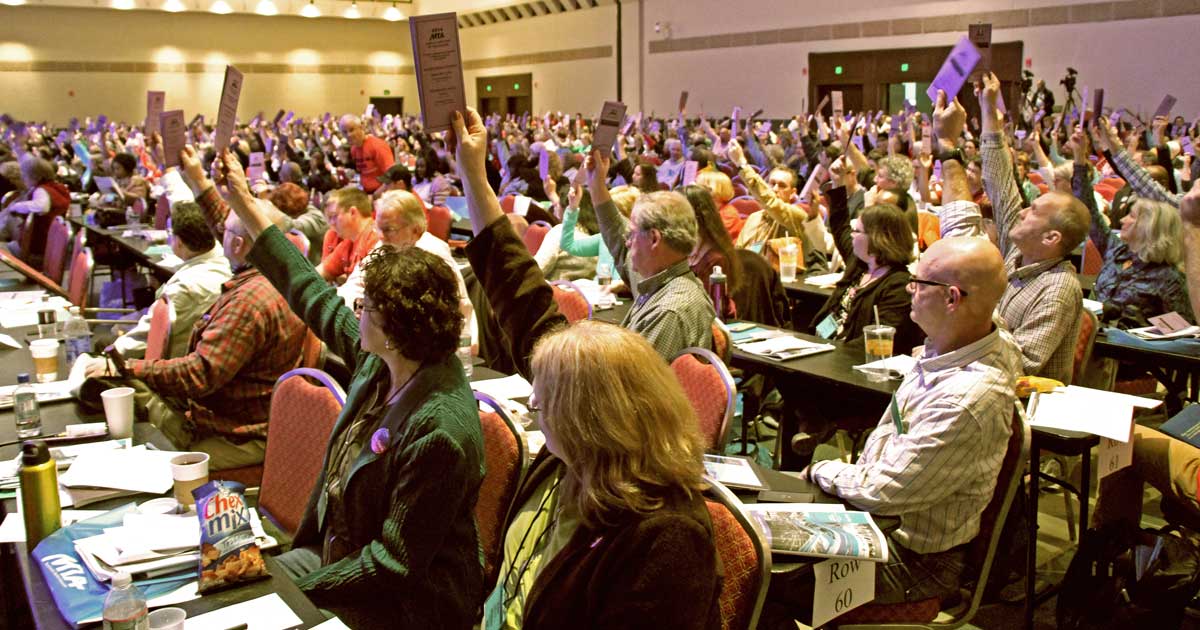MTA Governance Structure

Democracy at Work
Union strength grows with member participation in union governance from the local level to the state level to the national level. In order to deepen our union democracy, members need to understand the MTA’s governance structure and actively participate in decision-making.
Too many members are not aware of how MTA makes policy or how to impact our policies. The system can be complicated to the uninitiated — but don’t let that keep you away. We need member engagement that is wide and deep. Please take a few moments to review these brief descriptions of how things work and how you can participate. Then, get involved. We need your voice, your ideas and your passion.
How Our Process Works
The MTA is governed by a Board of Directors, which includes the president, vice president, executive director-treasurer (non-voting), the Executive Committee (eight regional positions, a statewide retiree position and an at-large statewide Education Support Professionals position), district directors (50 regional district directors and four statewide: two retirees, one at-large representative of ESPs and one at-large representative of ethnic minority members), and the Massachusetts NEA directors. These Board members are responsible for the general policies and interests of the MTA.
We need your voice, your ideas and your passion.
Executive Committee and Board seats are elected positions that represent constituents regionally or statewide. Get the electoral region and district for your local and find out who represents you on the Executive Committee and Board.
In order to maintain and deepen our union democracy, members should stay informed about the actions taken by the Board, be attentive to emerging issues and communicate with their Executive Committee and Board representatives about their concerns and policy expectations.
Get meeting agendas and action reports, as well as schedules. Members are always invited to attend meetings, and the Board meeting has a 30-minute public speaking time before each meeting.
Annual Meeting
Each May, the MTA convenes an Annual Meeting at which delegates from across the state gather to set policy, vote on Bylaws, Standing Rules and Resolutions, elect members to the Board, vote on the budget and approve new business items. Most delegates represent their locals and are elected locally. In addition, there are statewide retiree and regional ethnic minority delegates.

The Annual Meeting, generally with more than 1,000 delegates present, provides an amazing opportunity to experience the democratic process at work, but we never fill our delegate capacity.
NEA Representative Assembly
As an affiliate of the National Education Association, our national union, the MTA sends representatives to NEA Board meetings and to the annual NEA Representative Assembly (NEA RA). At this event, MTA members participate with education union workers from across the state — and across the nation — to set national policy for the NEA.
Election Structure
The President and Vice President are elected every two years.
Executive Committee members are elected by Annual Meeting delegates from their regions. Executive Committee members serve three-year terms.
Board seats: District directors are elected to serve on the Board for three-year terms. These terms of office rotate so that about one-third of the seats are open each year.
It is important to note that Board members are elected by delegates from each district at the MTA Annual Meeting; that is where the voting takes place. It’s all the more reason to actively engage yourself and others in becoming Annual Meeting delegates.
MTA delegates to the Annual Meeting are also elected within each local. If you want to nominate yourself to be a delegate from your local to the MTA Annual Meeting in May, we recommend that you send an email to your local president and vice president in January notifying them of your interest in serving as a delegate. Each local then runs its own election. If there are fewer candidates than seats, all candidates are selected, and no election is held. Keep in touch with your local leadership about this opportunity to participate in MTA governance.
There are also elections for retiree delegates and ethnic minority delegates.
NEA directors and statewide, regional and retired delegates to the NEA RA are elected in the spring.
Locals also elect delegates to the NEA RA. If you want to nominate yourself to be a delegate from your local to the NEA RA, send an email to your local president and vice president in January notifying them that you are doing so. The MTA also provides limited travel stipends for local delegates.
